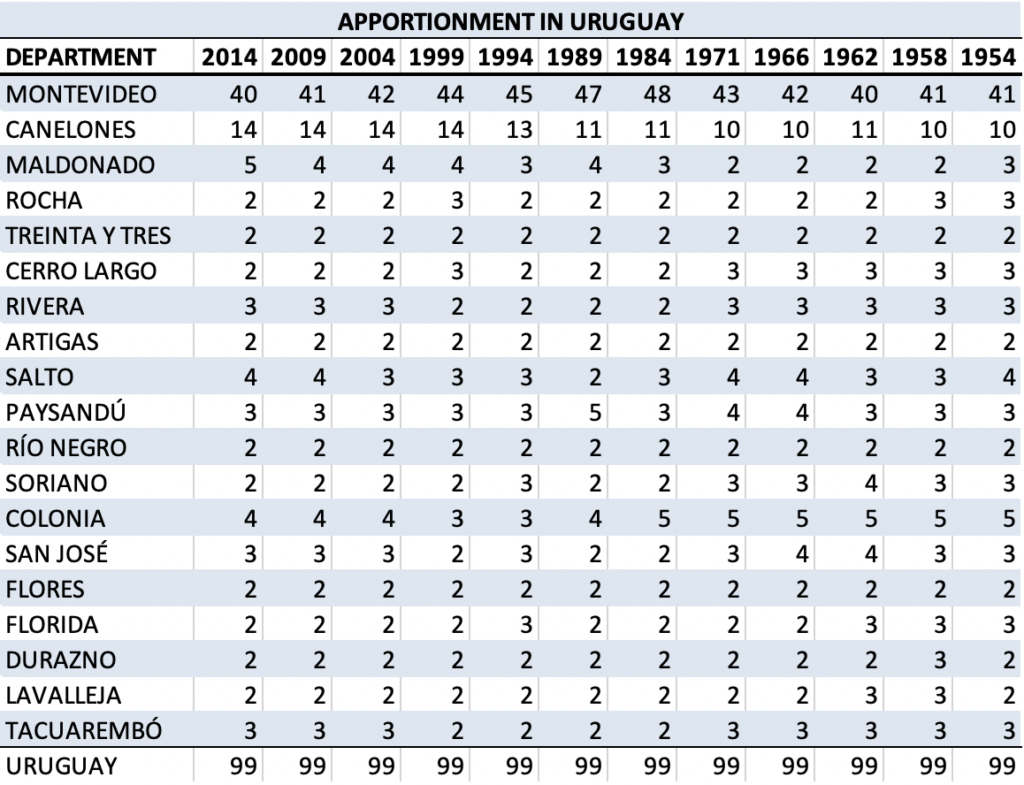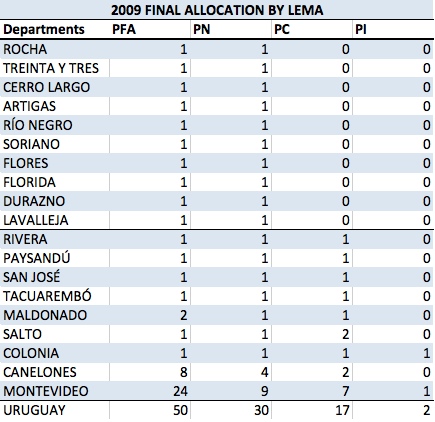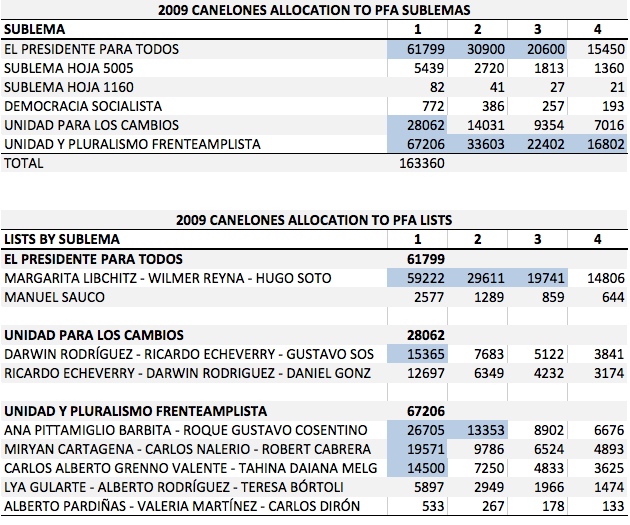Uruguay has a unique, complex electoral system for the House of Representatives (Cámara de Representantes) characterized by fusion between the presidential and legislative elections and use of the double simultaneous vote.
Uruguay 1 (1984-94)
During this period, Uruguay utilized the double simultaneous vote (DSV), or ley de lemas, to elect the president as well as the legislature. Each party, or lema, could have multiple presidential candidates. The lema whose candidates collectively gained the most votes received the presidency with the office awarded to the leading candidate of the winning lema. A lema required only a plurality, not a majority, to take the presidency.
The DSV allows a candidate to win with fewer votes than another candidate. In 1994, Tabaré Vásquez (Broad Front) received over 100,000 votes more than Julio María Sanguenetti (Colorado Party). However, Sanguenetti won the presidency because the three Colorado candidates together won more votes than Vásquez, the sole Broad Front candidate.
The DSV also operated for legislative elections. As at the presidential level, each faction, or sublema, within the same lema could field a list, or even multiple lists, of legislative candidates. But these lists are linked together such that casting a ballot for a specific House list also results in voting for a specific Senate list and presidential candidate. Multiple House lists could be linked to a single Senate list just as multiple Senate lists could be tied to a single presidential candidate. The following figure provides a schematic of the linkages (Morgenstern 2001):
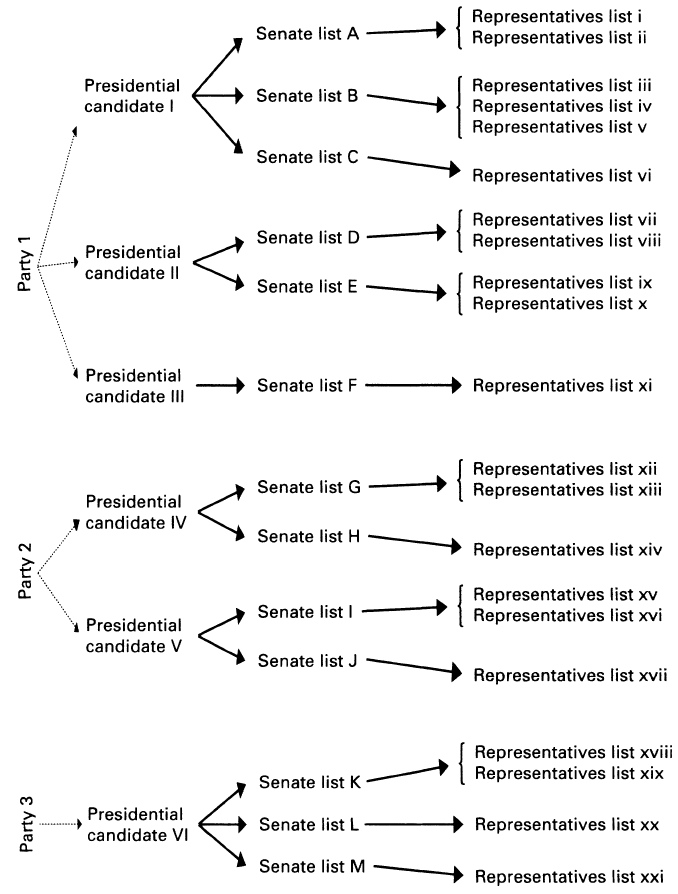 As the figure indicates, voters could not cast ballots for House and Senate candidates from different sublemas just as they could not vote for legislative and presidential candidates from different sublemas or lemas.
As the figure indicates, voters could not cast ballots for House and Senate candidates from different sublemas just as they could not vote for legislative and presidential candidates from different sublemas or lemas.
The allocation method of seats to lemas, sublemas, and lists within sublemas is detailed below.
Uruguay 2 (1999-)
Starting in 1999, Uruguay eliminated the DSV for presidential elections. Instead, it switched to a two-round system with party primaries to select each party’s nominee. In the first round of the general election, each party has one candidate who needs a majority of the vote to win election. If no candidate receives a majority in the first round, the two candidates with the most votes advance to the second round with the candidate with the most second round votes elected president.
Legislative elections continue to operate similarly as prior to 1999 with the DSV and fusion between votes for lists of candidates at different levels. However, all sublema lists are now linked to the sole presidential candidate of each lema with legislative elections occurring in conjunction with the first round of the presidential election.
Apportionment
Though the allocation of the 99 House seats is ultimately proportional the national vote for each lema, Uruguay also apportions seats among its 19 departments with each guaranteed a minimum of two mandates under Article 88 of the Constitution.
Prior to 1989, seats were apportioned to departments based on the total votes cast in each department in the immediately preceding election plus any new enrollments on the National Civic Registry in the Department since that election. Since 1989, Uruguay’s Electoral Court apportions seats based on the number of eligible voters. In both periods, once each department received its constitutional minimum of two seats, the remaining 61 seats were distributed to departments by the d’Hondt system. This apportionment takes into account the two seats already received by each department (i.e. the first quota for each department is calculated by dividing by 3 rather than 1).
The following table shows the apportionment of seats to departments over time:
Allocation: First and Second Scrutinies
The method of allocating seats to lemas (i.e. parties) and departments is quite complicated and best illustrated through an example. The following table shows the votes received by each lema in each department in 2009.
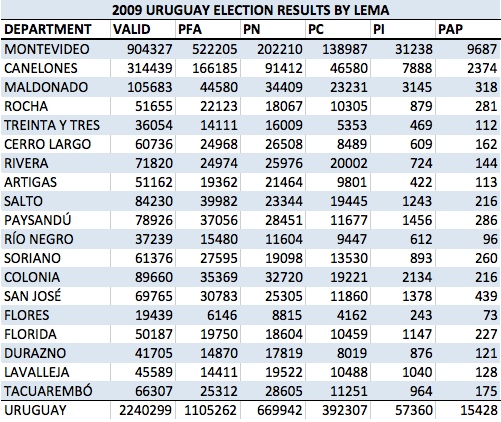 In the first scrutiny, lemas gain seats within departments for full multiples of the departmental Hare quota–the number of valid votes cast in the department divided by the number of seats apportioned to the department.
In the first scrutiny, lemas gain seats within departments for full multiples of the departmental Hare quota–the number of valid votes cast in the department divided by the number of seats apportioned to the department.
For example, in 2009, the Hare quota for Canelones was 314,439 valid votes divided by 14 seats, or 22,460. The PFA (Frente Amplio/Broad Front) garnered 166,185 votes in Canelones. As this total was 7.4 times the Hare quota, it immediately received 7 mandates in Canelones. The following table displays the Hare quota and seats won by each lema in the first scrutiny:
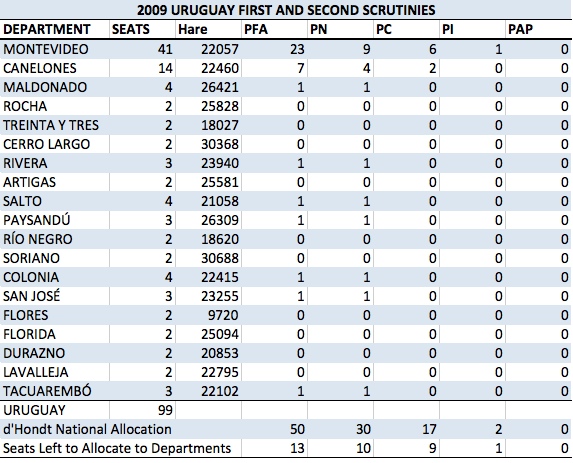 The second scrutiny determines each lema’s national seat total. The number each lema receives is calculated using the d’Hondt method based on total votes gained by a lema across Uruguay with no legal threshold to qualify to earn seats. The second to the last line of the above table shows the results of the d’Hondt calculation for 2009. The last line reveals the number of seats left to allocate to each lema after the first scrutiny allocation based on departmental Hare quotas.
The second scrutiny determines each lema’s national seat total. The number each lema receives is calculated using the d’Hondt method based on total votes gained by a lema across Uruguay with no legal threshold to qualify to earn seats. The second to the last line of the above table shows the results of the d’Hondt calculation for 2009. The last line reveals the number of seats left to allocate to each lema after the first scrutiny allocation based on departmental Hare quotas.
Allocation: Third Scrutiny
The third scrutiny allocates these seats to departments based on the d’Hondt quota for each lema within each department. The d’Hondt quota equals the number of votes received by the party in the department divided by the number of seats already gained in the first scrutiny plus 1. For example, the 2009 quota for the PFA in Canelones equals 166,185 votes divided by 8 seats (the 7 seats received in the first scrutiny plus 1), or 20,773. Once a party has gained a seat, a new d’Hondt quota can be calculated based on the new seat total (i.e. recalculate after raising the divisor by 1).
The initial set of d’Hondt quotas for each party in each department in 2009 are shown in the table below. Quotas highlighted in blue indicate that they gained a party 1 seat in the third scrutiny. The PC quota in Salto is highlighted in red to indicate that it won 2 seats in that department in the third scrutiny.
In the third scrutiny, Uruguay distributes seats first in departments that have yet to receive the constitutional minimum of two seats. Departments are ordered in the table below by the number of seats with departments having only two seats (the only departments in which no lemas had not yet gained 2 seats) listed above the line in the middle of the table (i.e. Lavalleja and above). In 2009, none of the these 10 departments had either of their 2 seats allocated in the first scrutiny, as shown in the second column of the table, so both seats had to be distributed in the second scrutiny, as shown in the third column.
The PFA and the PN (Nacional/National) each received 1 seat in these 10 departments because they had the highest two quotas of any party in all of them. (None of the first-place parties had more than double the votes of the second-place parties in any department, so its recalculated quota after receiving its seat was always below that of the second-place party.)
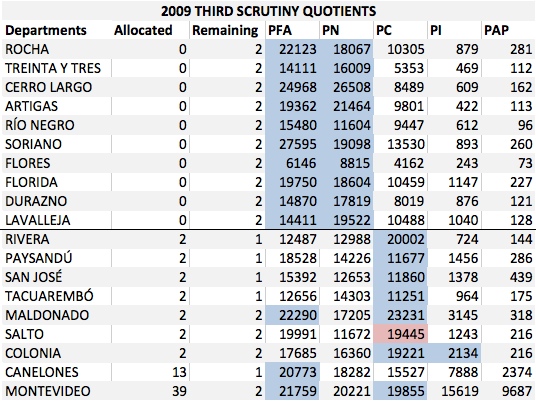 After this allocation, the PN has received all of the 10 additional seats it deserved according to the second scrutiny, so there is no need to take further into account the quotas for the party. Similarly, there was never any need to consider the PAP quotas, as the party was not entitled to any seats.
After this allocation, the PN has received all of the 10 additional seats it deserved according to the second scrutiny, so there is no need to take further into account the quotas for the party. Similarly, there was never any need to consider the PAP quotas, as the party was not entitled to any seats.
The second part of the third scrutiny allocates any seats left in the departments with 3 or more seats. As the third column of the above table indicates, all departments still needed to receive 1 or 2 seats. Seats are allocated in the order of d’Hondt quotas with lemas ceasing to participate in the distribution once they have received the number of seats merited according to the second scrutiny.
In 2009, the first seat went to the PC (Colorado) in Maldonado because its quota of 23,231 was the highest. The next seat went to the PFA in Maldonado for the second highest quota of 22,290. At this point, all seats had been allocated in Maldonado, so a party could not gain mandates there even if its quota there was higher than in other departments.
The third and fourth seats also went to the PFA in Montevideo and Canelones. These two seats brought the PFA up to the 63 total seats indicated by the second scrutiny, so it no longer participated in the distribution. Only the PC and PI were still eligible to gain seats.
The PC gained the fifth seat in Rivera, the sixth seat in Salto, the seventh seat in Montevideo, and the eighth seat in Colonia. The PI (Indipendiente/Independent) had the next highest quota with 15,619 in Montevideo but could not gain a seat there because all Montevideo seats were already filled. The next highest quota was held by the PC in Canelones, which faced the same problem as the PFA had already taken the last free seat in Canelones. As a result, the ninth seat went to the PC in San José. The PC also won the tenth seat in Paysandú and the eleventh seat in Tacuarembó.
At this point, only 2 seats remained to be allocated–1 in Salto and 1 in Colonia. The PC won its final seat in Salto where its recalculated quota of 9723 (i.e. 19,445/2) was higher than the quota for the PI in Salto or Colonia. The PI received its sole seat in Colonia even though its quota there was significantly lower than in 3 other departments.
The following table shows the final total allocation of seats to lemas by department:
Allocation to Candidates
Seats are allocated within each department and lema to sublemas and then to lists within sublemas based on the d’Hondt method. In departments where a lema gained only 1 seat, the allocation is simple: the seat goes to the highest ranked candidate on the list with the most votes in the sublema with the most votes (or, if there are not multiple lists within sublemas, just the highest ranked candidate on the sublema list). All lists are closed, though the choice among many lists may be viewed as a form of preference vote.
The following table shows the allocation to PN sublemas and lists in Maldonado in 2009. The PN won 1 seat. It went to the Todos por Maldonado sublema, as it received 21,727 of the 33,785 votes cast for the PN in Rocha. The seat was won by José Carlos Cardoso because he was the first candidate on the Ramiro Malcon-Elcira Rivero-Mauro Gallo list, which received more votes than the competing list within the Todos por Maldonado sublema.
The allocation process is more complicated in departments where a party wins multiple seats, as the following example of the allocation of seats first to sublemas and then to lists for PFA in Canelones in 2009 demonstrates.
Seats were first distributed to sublemas utilizing the d’Hondt method. The following table shows the series of d’Hondt quotas for each sublema–votes divided by seats already received plus 1 with blue highlights indicating the 8 largest quotas. One lema, El Presidente para Todos received 3 seats, while another, Unidad para Los Cambios, gained 1 seat. Unidad y Pluralismo Frenteamplista garnered 4 seats.
Seats then had to be distributed among the lists affiliated with the sublemas that won seats. Again, the d’Hondt method was utilized with the d’Hondt quotas shown in the above table. All 3 seats gained by the El Presidente para Todos sublema went to the Margarita Libchitz–Wilmer Reyna–Hugo Soto list. The Darwin Rodríguez–Ricardo Echeverry–Gustavo Sos list received the Unidad para Los Cambios sublema’s single seat. The top list, Ana Pittamiglio Barbita–Roque Gustavo Cosentino, in Unidad y Pluralismo Frenteamplista won two seats. The next two lists also gained a single seat apiece. As lists are closed, seats were given in list order to candidates on the appropriate list.
Sources: Scott Morgenstern, “Organized Factions and Disorganized Parties: Electoral Incentives in Uruguay,” Party Politics 7: 2(2001), 235-56; Manuel Alcántara Sáez and Ismael Crespo Martínez with Pablo Mieres, Partidos Politicos y Procesos Electorales en Uruguay, 1971-1990 (Madrid: Fundación Centro Español de Estudios de América Latina, CEDEAL 1992); Corte Electoral Uruguay.

